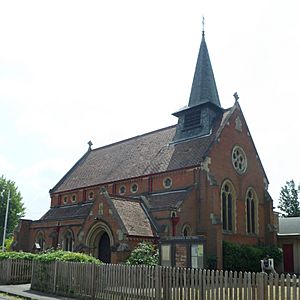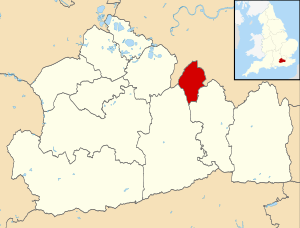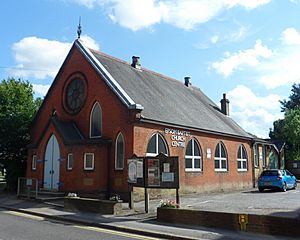List of places of worship in Epsom and Ewell facts for kids
Epsom and Ewell is a small area in Surrey, England. It has 29 churches and other places where people go to worship. Three other buildings used to be places of worship but are now used for different things.
Most people in Epsom and Ewell are Christian. Many churches here were built in the 20th century because more people moved to the area, which is close to London. But the towns of Ewell and Epsom are older, and their main churches have very old beginnings.
Some of these buildings are "listed." This means they are special because of their history or how they were built. It helps protect them. There are three levels of listed buildings:
- Grade I: Super important buildings, sometimes known around the world.
- Grade II*: Very important buildings, more special than just "special interest."
- Grade II: Important buildings with special interest.
As of 2001, Epsom and Ewell had no Grade I buildings, 15 Grade II* buildings, and 307 Grade II buildings. The local council also lists "locally listed" buildings, which are important to the area. One of these is a place of worship.
Contents
About Epsom and Ewell
Epsom and Ewell is the smallest district in Surrey. It's next to Greater London. In 2011, over 75,000 people lived here. The biggest towns are Ewell and Epsom.
Ewell started around 70 AD near a major Roman road. Epsom became famous in the 1600s and 1700s after Epsom Salts were discovered. It also became known for The Derby horse race, which started in 1779. Many houses were built when railway lines opened in the mid-1800s. More homes were added in the 1990s where old hospitals used to be.
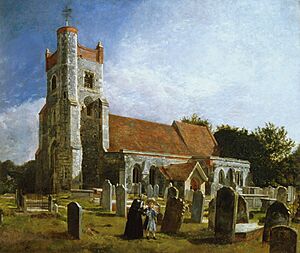
Ewell's old church, St Mary the Virgin, was replaced in 1848. But its 15th-century tower is still there. Epsom also had two churches in 1086, but only St Martin's Church remains today. As the population grew, many new Anglican churches were built, like Christ Church and St Barnabas' in Epsom, and All Saints in West Ewell.
Roman Catholic worship in Epsom started in the early 1800s. A permanent church was built in 1861 and rebuilt several times as more people joined. The current St Joseph's Church opened in 2001.
Protestant groups have a long history here too. William Bugby started a chapel in Epsom in 1779. This chapel later became a synagogue for a while. Presbyterian meetings happened in Epsom as early as 1667. The United Reformed Church in Epsom today continues this history. Baptists have met in Epsom since 1899, and Methodists since 1847.
After World War II, several Evangelical groups opened churches. You can also find a Kingdom Hall for Jehovah's Witnesses and a Latter-day Saints meetinghouse. There's a mosque for Muslims in Epsom and a Hindu temple in Stoneleigh.
Epsom and Ewell has about 23 active Christian churches for its 79,600 people. This means there's one church for every 3,460 people, which is a lot compared to other places in the country!
Religious Groups in Epsom and Ewell
In 2011, a survey showed how people in Epsom and Ewell identified their religion:
- 61.55% were Christian.
- 3.03% were Muslim.
- 2.55% were Hindu.
- 0.64% were Buddhist.
- 0.32% were Jewish.
- 0.17% were Sikh.
- 0.35% followed another religion.
- 24.31% said they had no religion.
- 7.09% did not say their religion.
The number of Christians was higher than the average for England. The numbers for Muslims, Sikhs, and Jews were slightly lower. However, there were more Hindus and Buddhists in Epsom and Ewell compared to the rest of England.
How Churches are Organized
Most Anglican churches in Epsom and Ewell belong to the Diocese of Guildford. This means they are part of a larger church family led by the Bishop of Guildford.
The Roman Catholic churches in Epsom and Ewell are part of the Epsom Deanery. This is a group of Catholic churches in the Roman Catholic Diocese of Arundel and Brighton.
Other churches, like Baptist, Methodist, and United Reformed churches, also have their own ways of organizing. For example, Epsom Baptist Church is part of the London Baptist Association. Many Evangelical churches are part of networks like the Fellowship of Independent Evangelical Churches (FIEC) or Affinity.
Special Listed Buildings
| Grade | Criteria |
|---|---|
| Grade I | Buildings of exceptional interest, sometimes considered to be internationally important. |
| Grade II* | Particularly important buildings of more than special interest. |
| Grade II | Buildings of national importance and special interest. |
| Locally listed (L) | Buildings considered by the council to be of "local architectural or historic interest". |
Places of Worship Today
| Name | Image | Location | Religion | Grade | Notes | Refs |
|---|---|---|---|---|---|---|
| Christ Church Epsom Common (More images) |
 |
Epsom 51°20′05″N 0°17′07″W / 51.3346°N 0.2853°W |
Anglican | II* | This church has been here since 1843. The current building was rebuilt in 1876 in a Gothic style. It has a tower from 1887 with eight bells. | |
| St Martin's Church (More images) |
 |
Epsom 51°19′51″N 0°15′32″W / 51.3309°N 0.2589°W |
Anglican | II* | Only parts of the old 15th-century tower remain. The church was rebuilt in 1824 and again in 1904. It's made of flint, stone, and stucco. | |
| St Barnabas' Church (More images) |
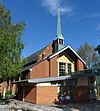 |
Epsom 51°20′19″N 0°16′05″W / 51.3387°N 0.2681°W |
Anglican | – | The first St Barnabas' was a simple "tin tabernacle" in 1899. A larger church was built in 1908-1909 using local bricks. It has been extended over the years. | |
| Epsom Baptist Church (More images) |
 |
Epsom 51°20′00″N 0°15′47″W / 51.3333°N 0.2630°W |
Baptist | – | This group started meeting in 1899. The current building on Church Street opened in 1909. | |
| Epsom Christian Fellowship (More images) |
 |
Epsom 51°20′02″N 0°16′27″W / 51.3340°N 0.2742°W |
Evangelical | – | This group started as a small house church in the 1970s. They bought and converted a building into a church in 1984. Part of it became a school in 1988. | |
| Epsom Methodist Church (More images) |
 |
Epsom 51°19′56″N 0°15′59″W / 51.3323°N 0.2663°W |
Methodist | – | Methodists first met in Epsom in 1840. A chapel was built in 1863, but it became too small. The current stone church opened in 1914 and can hold 270 people. | |
| Epsom Islamic Centre (More images) |
 |
Epsom 51°20′20″N 0°16′01″W / 51.3388°N 0.2669°W |
Muslim | – | This mosque and community center can hold 500 people. It's in a building that used to be a church hall. | |
| St Joseph's Church (More images) |
 |
Epsom 51°19′47″N 0°16′28″W / 51.3296°N 0.2744°W |
Roman Catholic | – | Epsom's first Catholic church was built in 1861. The current, larger church opened in 2001. | |
| Grace Baptist Church (More images) |
 |
Epsom 51°19′33″N 0°16′38″W / 51.3259°N 0.2773°W |
Strict Baptist | – | This group started in 1889. They used Bugby Chapel until their current building opened in 1951. It was first called Salem and then Dorking Road Baptist Chapel. | |
| Epsom United Reformed Church (More images) |
 |
Epsom 51°19′57″N 0°15′40″W / 51.3325°N 0.2612°W |
United Reformed Church | – | This church was built in 1963. Its history goes back 300 years. The building has a unique curved upper floor. | |
| St Mary the Virgin's Church (More images) |
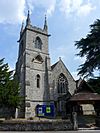 |
Ewell 51°21′08″N 0°14′56″W / 51.3521°N 0.2489°W |
Anglican | II | The old church was taken down in 1848, but its tower still stands. The new church was built in a Gothic style and can hold almost 900 people. | |
| Christ Church Ewell (More images) |
 |
Ewell 51°20′56″N 0°14′52″W / 51.3488°N 0.2479°W |
Evangelical | – | This church opened in 1955 as Staneway Chapel. It became Christ Church Ewell in 2002. | |
| The King's Church | Ewell 51°20′46″N 0°15′43″W / 51.3462°N 0.2620°W |
Evangelical | – | This church was established in 1986 as Epsom Evangelical Church. The current building, with its new name, opened in 1993. | ||
| Kingdom Hall (More images) |
 |
Ewell 51°20′35″N 0°14′09″W / 51.3431°N 0.2359°W |
Jehovah's Witnesses | – | This Kingdom Hall opened in 1997, replacing an older one. It's used by two groups of Jehovah's Witnesses. | |
| Church of Jesus Christ of Latter-day Saints, Epsom Chapel (More images) |
 |
Ewell 51°20′31″N 0°14′01″W / 51.3420°N 0.2335°W |
Latter-day Saint | – | This meetinghouse for the Church of Jesus Christ of Latter-day Saints opened in 1964. | |
| St Clement's Church (More images) |
 |
Ewell 51°21′52″N 0°15′34″W / 51.3644°N 0.2594°W |
Roman Catholic | – | Ewell's Catholic church was designed in 1962. It has a tall, slim bell tower and zigzag walls with stained glass. | |
| Glyn Hall (Mary Edwards Spiritualist Church) |  |
Ewell 51°20′57″N 0°14′55″W / 51.3491°N 0.2485°W |
Spiritualist | – | This building used to be a "tin tabernacle" for another Christian group. Since 2003, it has been a Spiritualist church, renamed after its founder. | |
| St Michael's Church, The Sanctuary (More images) |
 |
Ewell 51°20′59″N 0°14′54″W / 51.3498°N 0.2484°W |
Spiritualist | L | This building was once a malthouse. It became a Spiritualist church in 1954 and is now a locally listed building. | |
| Ewell United Reformed Church (More images) |
 |
Ewell 51°21′14″N 0°14′51″W / 51.3539°N 0.2474°W |
United Reformed Church | – | Ewell's first Nonconformist church was a simple wooden building from 1825. The current brick church opened in 1938. | |
| St Paul's Howell Hill Church (More images) |
 |
Howell Hill 51°20′47″N 0°13′32″W / 51.3464°N 0.2255°W |
Anglican | – | This church was rebuilt in 1989. It shares a parish with St Mary's Church in a nearby district. | |
| St Stephen-on-the-Downs Church (More images) |
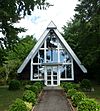 |
Langley Vale 51°18′26″N 0°15′51″W / 51.3071°N 0.2643°W |
Anglican | – | The current church in this village was built in 1961. Before that, a "tin tabernacle" stood on the same site. | |
| St John the Baptist's Church (More images) |
 |
Stoneleigh 51°21′48″N 0°14′57″W / 51.3634°N 0.2491°W |
Anglican | – | The first Anglican building in Stoneleigh was a church hall in 1936. The current red-brick church was built later, with a tower added in 1958. | |
| Stoneleigh Baptist Church (More images) |
 |
Stoneleigh 51°21′39″N 0°14′28″W / 51.3608°N 0.2411°W |
Baptist | – | Baptists started meeting in Stoneleigh in 1934. A church hall was built in 1935, and a permanent church was completed in 1962. | |
| Sri Raja Rajeswari Amman Temple |  |
Stoneleigh 51°21′43″N 0°14′45″W / 51.3620°N 0.2459°W |
Hindu | – | This Hindu temple is also known as Parasakthi Hindu (Saiva) Temple. It opened for worship in 1995. | |
| Stoneleigh Methodist Church (More images) |
 |
Stoneleigh 51°21′57″N 0°14′57″W / 51.3659°N 0.2493°W |
Methodist | – | A Methodist group started here in 1936. A church hall opened in 1938. A new, larger church was built in 1955 to meet growing needs. | |
| All Saints Church (More images) |
 |
West Ewell 51°21′19″N 0°15′56″W / 51.3554°N 0.2656°W |
Anglican | – | Ewell's second Anglican church opened in 1894. It's built with red brick and stone and has a small wooden bell tower. | |
| Ruxley Church (More images) |
 |
West Ewell 51°21′52″N 0°16′06″W / 51.3645°N 0.2684°W |
Anglican/Methodist | – | An Anglican church here was demolished in 1996. Its members joined the nearby Methodist church. A new church (pictured) was built on the old site and opened in 2013. | |
| West Ewell Evangelical Church (More images) |
 |
West Ewell 51°21′23″N 0°16′13″W / 51.3563°N 0.2704°W |
Evangelical | – | This group started as a Sunday school in 1939. A permanent church was built in 1952 and rebuilt in 1990, keeping its original front. | |
| St Mary the Virgin's Church (More images) |
 |
Worcester Park 51°22′35″N 0°15′22″W / 51.3765°N 0.2561°W |
Anglican | II | This church was designed in 1895. It replaced an ancient church that was demolished for King Henry VIII's Nonsuch Palace. It's mostly made of flint. |
Former Places of Worship
| Name | Image | Location | Religion | Grade | Notes | Refs |
|---|---|---|---|---|---|---|
| St John's Church (More images) |
 |
Epsom 51°20′13″N 0°15′31″W / 51.3369°N 0.2586°W |
Anglican | – | Built in 1884, this church was used until at least 1954. It's now a nursery school. | |
| Bugby Chapel (More images) |
 |
Epsom 51°20′07″N 0°15′41″W / 51.3353°N 0.2614°W |
Independent Calvinistic | II | This chapel was used for over 200 years, starting in 1779. It was a Calvinist church, then Unitarian, then Strict Baptist, and finally a synagogue until 1994. It's now an office. | |
| Kingdom Hall |  |
Ewell 51°21′17″N 0°14′42″W / 51.3548°N 0.2451°W |
Jehovah's Witnesses | – | This building was a Kingdom Hall from 1958 until 1997, when a new one opened. It's now used for businesses. |
Former Places of Worship Demolished Since 2000
| Name | Image | Location | Religion | Grade | Notes | Refs |
|---|---|---|---|---|---|---|
| Ruxley Church (old building) (More images) |
 |
West Ewell 51°21′50″N 0°16′19″W / 51.3640°N 0.2719°W |
Anglican/Methodist | – | This building was Ruxley Methodist Church from 1965. It became a joint Anglican and Methodist church in 2002. It closed in 2013 when a new church was built, and this old building was then demolished. |


